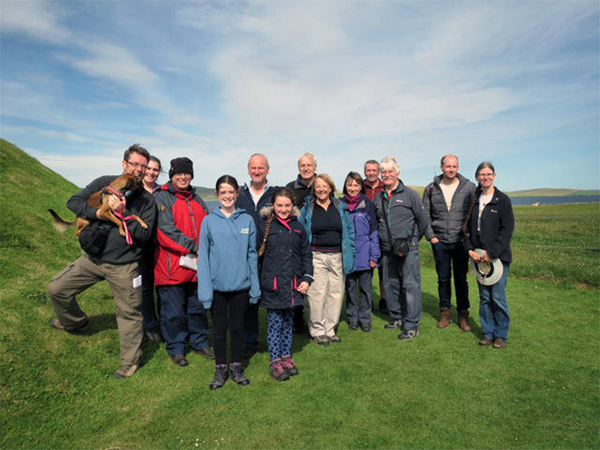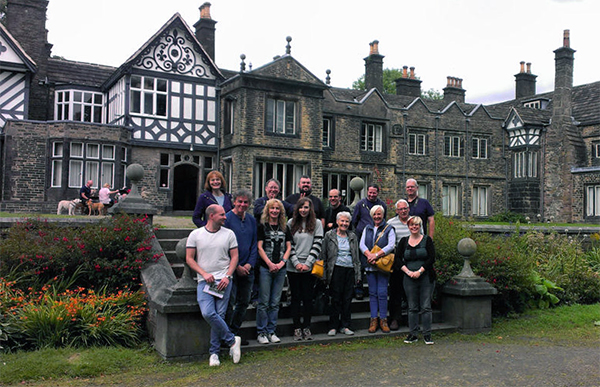
Orkney
Only 13 of us made this trip which took place at the end of July. However it was well worth the journey and the weather was very kind to us. We all made our different ways there but met up for 2 days together on the island. In previous weeks Darren had arranged a programme for us, including some tours booked in advance. On the first day we saw the Tomb of Ustan, Maeshowe, the Ness of Brodgar and Skara Brae. Difficult to pick a favourite - the stonework of Maeshowe is incredible (some stones weigh up to 30 tons) - and the 5000 year old village complex at Skara Brae, well what can you say. For me, seeing the live excavations on the Ness of Brodgar was the highlight. A huge Neolithic housing complex is being uncovered with dates emerging older than anywhere else in the British Isles - quite outstanding. On the second day we visited the Stones of Stenness, the Barnhouse Settlement, the Ring of Brodgar and the Broch of Gurness.
The Stones of Stenness, being over 5000 years old, is thought to be the oldest henge monument in the British Isles. Only a few stones remain but these monoliths are over 5 metres high. The Ring of Brodgar is much bigger in diameter and has many more surviving stones but is thought to be contemporary with both the Ness and the Stones of Stenness. For our last visit of the day, to the Broch of Gurness, we jump 3000 years to the Iron Age - still quite an exceptional site with its surrounding village complex and its position overlooking the Eynhallow Sound. It was only discovered in 1925 when a local antiquarian's stool fell into it while he was sketching the Sound. All in all, it was a spectacular trip and you can see more images on our blog site here.

Bolton's Ancient Halls
Last month Ian Trumble, who works for Museums Association Bolton, was able to arrange a special visit for us to Hall i'th Wood. Built in the 16th century, this timber framed hall lies on the outskirts of Bolton, just off Crompton Way to the north. It was the home of Samuel Crompton who invented the Spinning Mule, a machine that revolutionised the cotton industry in Lancashire in the 18th century. The Hall is now a museum housing collections of furniture and other artefacts from around the region. In the afternoon Ian had booked us on a tour of the nearby Smithills Hall, but before joining it, we had the unique opportunity of visiting Chadwick Resource Centre which houses the Bolton Museum Archive. This carbon-neutral building houses a vast collection of artefacts from around the world dating from the prehistoric to the recent past. It also has the latest facilities for researching and conserving the objects in store. Ian was only able to show us a small selection but perhaps the highlight was a collection of Peruvian textile samples dating to the 16th century. As it turned out the tour guide didn't turn up at Smithills Hall, but Ian was able to step in with an impromptu tour. The Hall is a fascinating building, with some parts dating to the early 14th century. It has some remarkable features including a step in the door of one of the rooms which is said to have the footprint of the preacher George Marsh, who was martyred in the 16th century. A great day out and I would like to thank Ian for his time and effort in organising it for us. You can see more images on our blog site here.
Talk on Kom El Hatan
On Friday 6th October, Dr Hourig Sourouzian will be speaking to the Horus Society about last years excavation work in which she has made some amazing find at Kom El Hatan (Mortuary Temple of Amenhotep III). Guests are welcome and the fee is £20 but includes a meal. Horus have been involved in fund raising for this site for the last 16 years. It is the most important modern excavation in Egypt and is the largest single temple in the valley. To book please ring 01942 716557 (venue is the Springfield Lounge at the DW Stadium Wigan and the meal starts at 7.15pm).
Next Meeting
Wednesday 6th September. - in the Standish Suite at the Brocket Arms (7.30pm as usual). In 1675 the Royal Yacht Mary was sunk off Anglesey after crashing into the Skerries rocks in dense fog. Of the 74 passengers and crew only 39 survived and even then only after 2 days stranded on the rocks. The ship was a gift from the Dutch to Charles II and was the first of many to be owned by him. When it sank it was carrying dignitaries from Dublin to Chester. In 1971 the wreck was discovered by the Chorley Sub Aqua Club who managed to recover many of the guns. Our own Boyd Harris was a member of the Club and helped in the recovery operations. I'm sure his talk on the history and recovery of the Royal Yacht will be absolutely fascinating. Hope to see you then- BA
|



